ignition Citroen JUMPY 2008.5 2.G Owner's Guide
[x] Cancel search | Manufacturer: CITROEN, Model Year: 2008.5, Model line: JUMPY, Model: Citroen JUMPY 2008.5 2.GPages: 185, PDF Size: 6.66 MB
Page 43 of 185

41
Steering wheel controls
ERGONOMICS and COMFORT
3
Special position of the windscreen
wipers
In the minute following switching off of the
ignition, any action on the stalk positions the
wipers against the windscreen uprights. This action enables you to position the
wiper blades for winter parking, cleaning or
replacement.
Refer to the "Changing a windscreen
wiper blade" section of chapter 8.
When using an automatic car wash,
switch off the ignition to avoid
triggering of the automatic wiping.
In winter, it is advisable to wait for the
windscreen to completely clear of ice before
operating the automatic wipe.
Rear windscreen wiper
Turn the ring to the first notch. Rear windscreen wash
Turn the ring past the first notch:
the windscreen wash then the
windscreen wiper operate for a
fixed time.
In winter, in the event of a considerable
amount of snow or ice, switch on the
rear screen demister. Once de-icing is
complete, remove the snow or ice which has
accumulated on the rear wiper blade. You
can then operate the rear windscreen wiper.
To park the wipers in their normal position
after this has been done, switch on the
ignition and move the stalk.
Activation
Press the control downwards. Activation of
the function is accompanied by a message
on the display.
The automatic windscreen wipers function
must be reactivated if the ignition has been
switched off for more than one minute, by
pressing the stalk downwards.
Deactivation/Switching off
Place the windscreen wipers stalk in
position
I , 1 or 2 . Deactivation of the function
is accompanied by a message on the
display.
In the event of malfunction of the automatic
windscreen wipers, the windscreen wipers
will operate in intermittent mode.
Contact a CITROËN dealer to have the
system checked.
Page 46 of 185
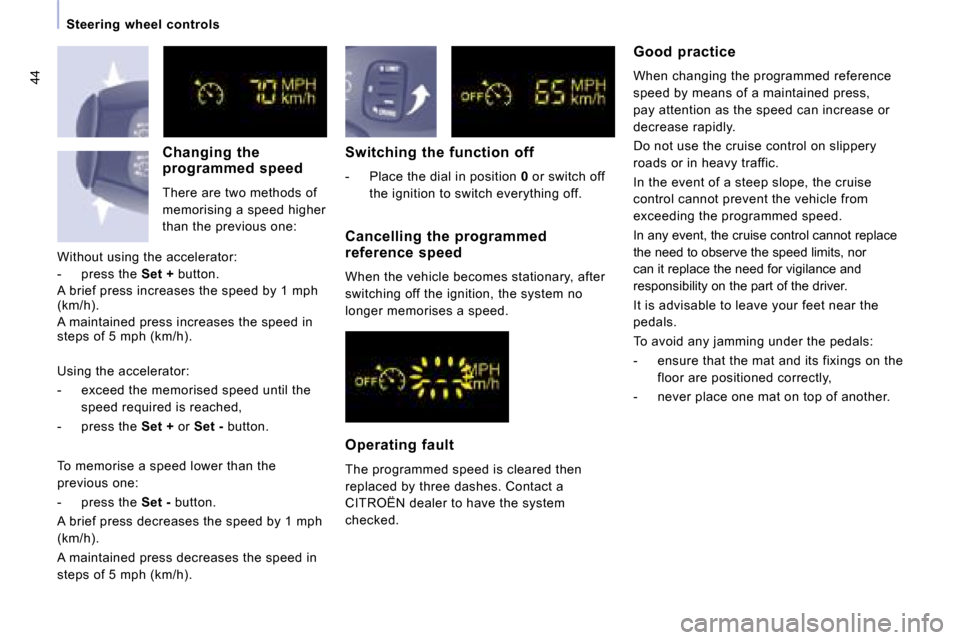
44
Steering wheel controls Switching the function off
- Place the dial in position 0 or switch off
the ignition to switch everything off. Good practice
When changing the programmed reference
speed by means of a maintained press,
pay attention as the speed can increase or
decrease rapidly.
Do not use the cruise control on slippery
roads or in heavy traffic.
In the event of a steep slope, the cruise
control cannot prevent the vehicle from
exceeding the programmed speed.
In any event, the cruise control cannot replace
the need to observe the speed limits, nor
can it replace the need for vigilance and
responsibility on the part of the driver.
It is advisable to leave your feet near the
pedals.
To avoid any jamming under the pedals:
- ensure that the mat and its fixings on the
floor are positioned correctly,
- never place one mat on top of another.
Changing the
programmed speed
There are two methods of
memorising a speed higher
than the previous one:
Without using the accelerator:
- press the Set + button.
A brief press increases the speed by 1 mph
(km/h).
A maintained press increases the speed in
steps of 5 mph (km/h). Cancelling the programmed
reference speed
When the vehicle becomes stationary, after
switching off the ignition, the system no
longer memorises a speed.
Using the accelerator:
- exceed the memorised speed until the speed required is reached,
- press the Set + or Set - button.
To memorise a speed lower than the
previous one:
- press the Set - button.
A brief press decreases the speed by 1 mph
(km/h).
A maintained press decreases the speed in
steps of 5 mph (km/h). Operating fault
The programmed speed is cleared then
replaced by three dashes. Contact a
CITROËN dealer to have the system
checked.
Page 49 of 185
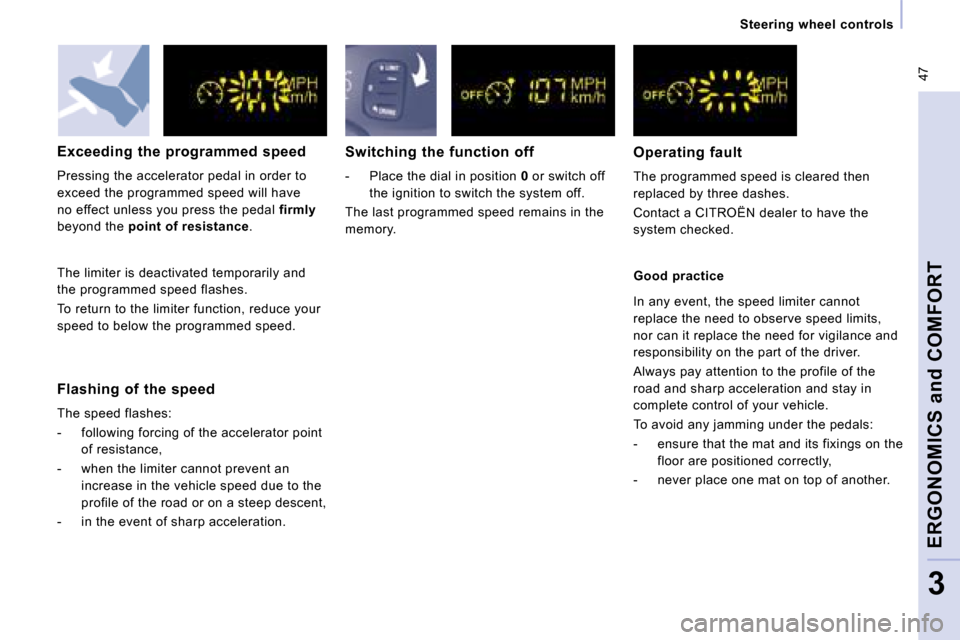
47
Steering wheel controls
ERGONOMICS and COMFORT
3
Flashing of the speed
The speed flashes:
- following forcing of the accelerator point of resistance,
- when the limiter cannot prevent an increase in the vehicle speed due to the
profile of the road or on a steep descent,
- in the event of sharp acceleration.
Exceeding the programmed speed
Pressing the accelerator pedal in order to
exceed the programmed speed will have
no effect unless you press the pedal
firmly
beyond the point of resistance .
Good practice
Operating fault
The programmed speed is cleared then
replaced by three dashes.
Contact a CITROËN dealer to have the
system checked.
The limiter is deactivated temporarily and
the programmed speed flashes.
To return to the limiter function, reduce your
speed to below the programmed speed. Switching the function off
- Place the dial in position
0 or switch off
the ignition to switch the system off.
The last programmed speed remains in the
memory.
In any event, the speed limiter cannot
replace the need to observe speed limits,
nor can it replace the need for vigilance and
responsibility on the part of the driver.
Always pay attention to the profile of the
road and sharp acceleration and stay in
complete control of your vehicle.
To avoid any jamming under the pedals:
- ensure that the mat and its fixings on the floor are positioned correctly,
- never place one mat on top of another.
Page 53 of 185

51
Ventilation
ERGONOMICS and COMFORT
3
Driver or passenger side comfort value
The value indicated on the display
corresponds to a level of comfort and
not a temperature in degrees Celsius or
Fahrenheit.
Automatic operation
Do not cover the sunshine sensor,
located on the windscreen behind the
mirror, it is used for regulation of the air
conditioning.
AUTO comfort programme
This is the normal air conditioning system
operating mode.
Press this button, the
AUTO symbol
is displayed.
In accordance with the comfort
value selected, the system controls
the distribution, the flow and the intake of air to
guarantee comfort and a sufficient circulation
of air in the passenger compartment. No
further action on your part is required.
When the engine is cold, to prevent an
excessive diffusion of cold air, the ventilation
will reach its optimum level gradually.
For your comfort, the settings are stored when
the ignition is switched off and are reinstated
the next time the vehicle is started, if the
temperature in the passenger compartment
�h�a�s� �n�o�t� �c�h�a�n�g�e�d� �s�i�g�n�i�fi� �c�a�n�t�l�y�;� �o�t�h�e�r�w�i�s�e�,�
operation resumes in automatic mode. Turn this control to the left or to
the right to decrease or increase
the value. A setting around the
value 21 provides optimum
comfort. However, depending on your
requirements, a setting between 18 and 24
is usual.
Page 67 of 185

66
Practical information
COURTESY LIGHTS
Automatic switching on/off
The front courtesy light comes on when
the key is removed from the ignition, when
the vehicle is unlocked, when one of the
front doors is opened and for location of the
vehicle using the remote control.
It switches off gradually after the ignition is
switched on and when the vehicle is locked. Permanently on, ignition on. Cab: comes on when one of the
front doors is opened.
Load space: comes on when one
of the rear doors is opened.
If the doors remain open for a few
minutes, the courtesy lights are
switched off.
Permanently off. Front individual reading lights
Rear courtesy light
These are switched on and off by
means of a manual switch, with the
ignition on.
Areas for toll cards/car park tickets
The athermic windscreen has
two non-reflective zones located either side
of the base of the interior mirror.
They are intended for affixing toll cards
and/or car park tickets.
Front courtesy light
Page 69 of 185
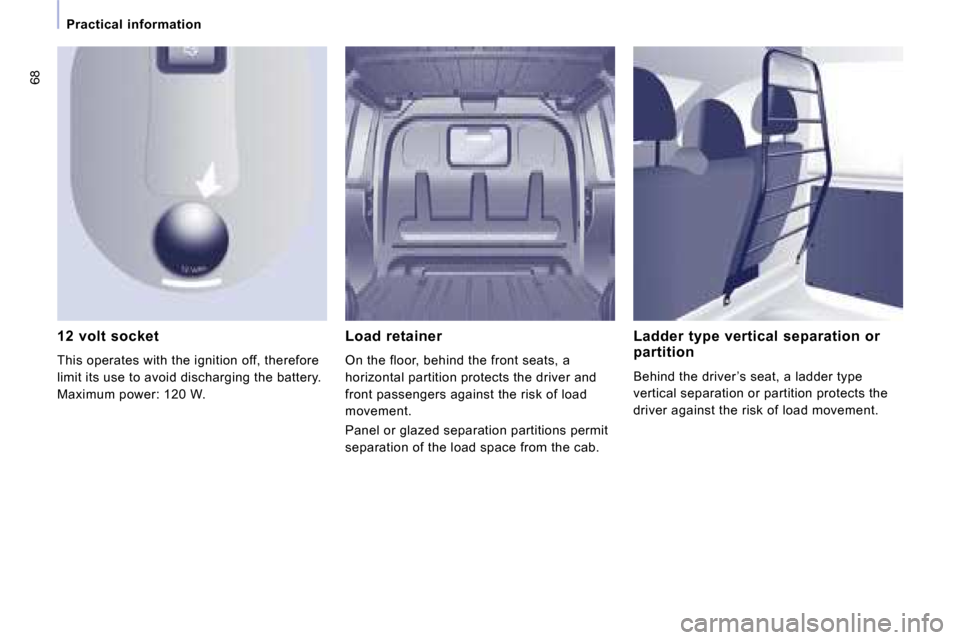
68
Practical information
12 volt socket
This operates with the ignition off, therefore
limit its use to avoid discharging the battery.
Maximum power: 120 W. Ladder type vertical separation or
partition
Behind the driver ’s seat, a ladder type
vertical separation or partition protects the
driver against the risk of load movement.
Load retainer
On the floor, behind the front seats, a
horizontal partition protects the driver and
front passengers against the risk of load
movement.
Panel or glazed separation partitions permit
separation of the load space from the cab.
Page 71 of 185
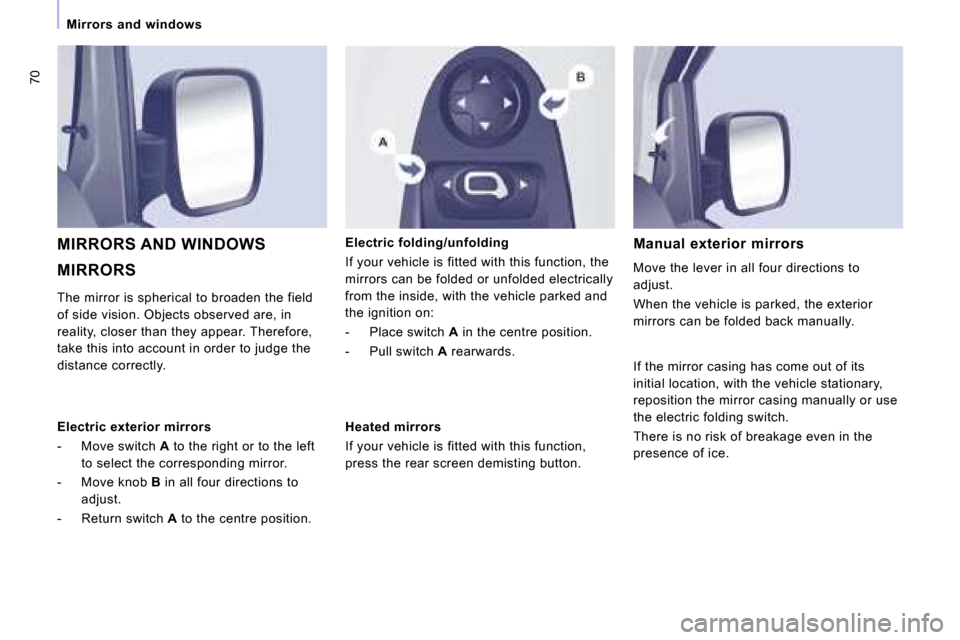
70
Mirrors and windows
MIRRORS
MIRRORS AND WINDOWS Electric folding/unfolding
If your vehicle is fitted with this function, the
mirrors can be folded or unfolded electrically
from the inside, with the vehicle parked and
the ignition on:
- Place switch A in the centre position.
- Pull switch A rearwards. Manual exterior mirrors
Move the lever in all four directions to
adjust.
When the vehicle is parked, the exterior
mirrors can be folded back manually.
The mirror is spherical to broaden the field
of side vision. Objects observed are, in
reality, closer than they appear. Therefore,
take this into account in order to judge the
distance correctly.
Heated mirrors
If your vehicle is fitted with this function,
press the rear screen demisting button. If the mirror casing has come out of its
initial location, with the vehicle stationary,
reposition the mirror casing manually or use
the electric folding switch.
There is no risk of breakage even in the
presence of ice.
Electric exterior mirrors
- Move switch
A to the right or to the left
to select the corresponding mirror.
- Move knob B in all four directions to
adjust.
- Return switch A to the centre position.
Page 73 of 185
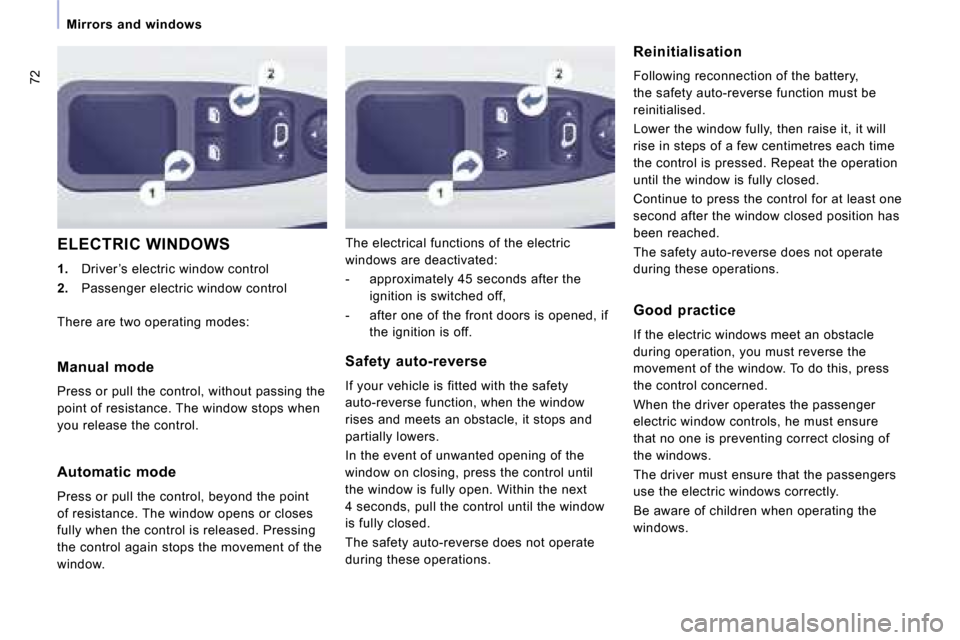
72
Mirrors and windows
ELECTRIC WINDOWS
1. Driver ’s electric window control
2. Passenger electric window control The electrical functions of the electric
windows are deactivated:
- approximately 45 seconds after the
ignition is switched off,
- after one of the front doors is opened, if the ignition is off. Reinitialisation
Following reconnection of the battery,
the safety auto-reverse function must be
reinitialised.
Lower the window fully, then raise it, it will
rise in steps of a few centimetres each time
the control is pressed. Repeat the operation
until the window is fully closed.
Continue to press the control for at least one
second after the window closed position has
been reached.
The safety auto-reverse does not operate
during these operations.
Manual mode
Press or pull the control, without passing the
point of resistance. The window stops when
you release the control.
Automatic mode
Press or pull the control, beyond the point
of resistance. The window opens or closes
fully when the control is released. Pressing
the control again stops the movement of the
window. Safety auto-reverse
If your vehicle is fitted with the safety
auto-reverse function, when the window
rises and meets an obstacle, it stops and
partially lowers.
In the event of unwanted opening of the
window on closing, press the control until
the window is fully open. Within the next
4 seconds, pull the control until the window
is fully closed.
The safety auto-reverse does not operate
during these operations. Good practice
If the electric windows meet an obstacle
during operation, you must reverse the
movement of the window. To do this, press
the control concerned.
When the driver operates the passenger
electric window controls, he must ensure
that no one is preventing correct closing of
the windows.
The driver must ensure that the passengers
use the electric windows correctly.
Be aware of children when operating the
windows.
There are two operating modes:
Page 122 of 185
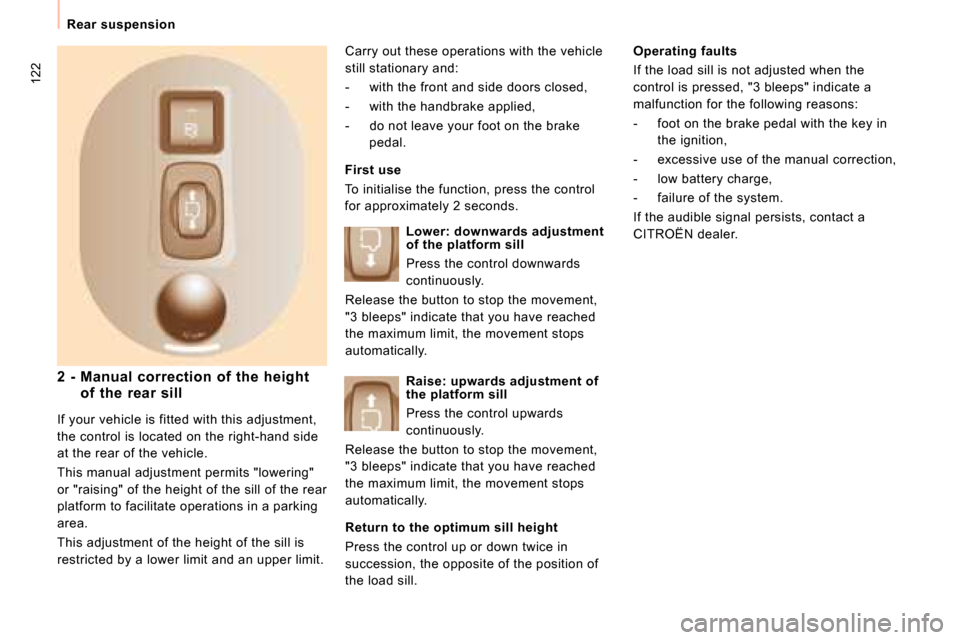
122
Rear suspension
2 - Manual correction of the height of the rear sill First use
To initialise the function, press the control
for approximately 2 seconds.
Return to the optimum sill height
Press the control up or down twice in
succession, the opposite of the position of
the load sill.
Carry out these operations with the vehicle
still stationary and:
- with the front and side doors closed,
- with the handbrake applied,
- do not leave your foot on the brake
pedal.
If your vehicle is fitted with this adjustment,
the control is located on the right-hand side
at the rear of the vehicle.
This manual adjustment permits "lowering"
or "raising" of the height of the sill of the rear
platform to facilitate operations in a parking
area.
This adjustment of the height of the sill is
restricted by a lower limit and an upper limit. Lower: downwards adjustment
of the platform sill
Press the control downwards
continuously.
Release the button to stop the movement,
"3 bleeps" indicate that you have reached
the maximum limit, the movement stops
automatically.
Raise: upwards adjustment of
the platform sill
Press the control upwards
continuously.
Release the button to stop the movement,
"3 bleeps" indicate that you have reached
the maximum limit, the movement stops
automatically. Operating faults
If the load sill is not adjusted when the
control is pressed, "3 bleeps" indicate a
malfunction for the following reasons:
- foot on the brake pedal with the key in
the ignition,
- excessive use of the manual correction,
- low battery charge,
- failure of the system.
If the audible signal persists, contact a
CITROËN dealer.
Page 123 of 185
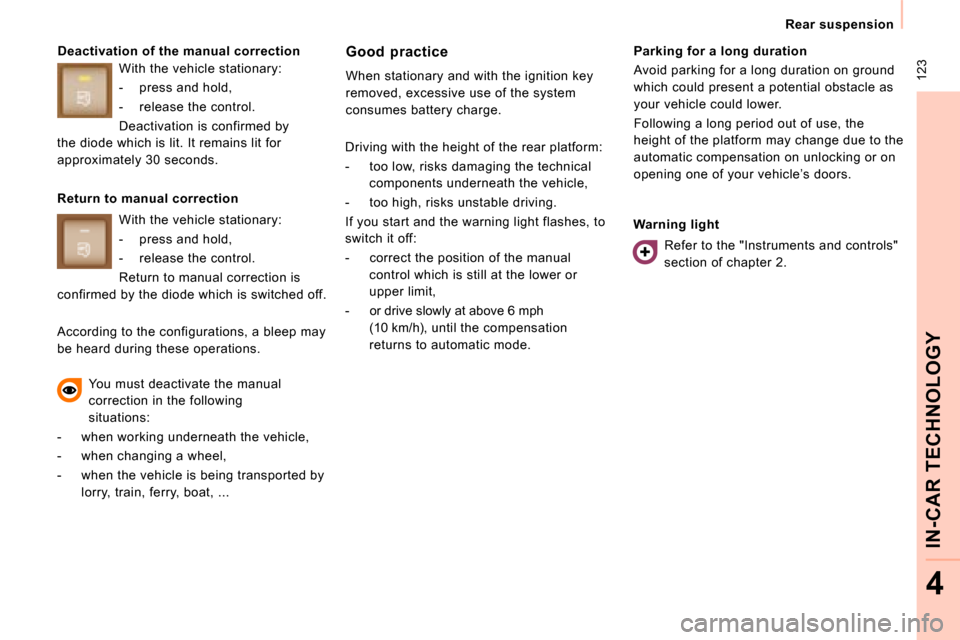
123
Rear suspension
IN-CAR TECHNOLOGY
4
Deactivation of the manual correction Good practice
When stationary and with the ignition key
removed, excessive use of the system
consumes battery charge. Parking for a long duration
Avoid parking for a long duration on ground
which could present a potential obstacle as
your vehicle could lower.
Following a long period out of use, the
height of the platform may change due to the
automatic compensation on unlocking or on
opening one of your vehicle’s doors.
With the vehicle stationary:
- press and hold,
- release the control.
Deactivation is confirmed by
the diode which is lit. It remains lit for
approximately 30 seconds.
Return to manual correction
According to the configurations, a bleep may
be heard during these operations.
You must deactivate the manual
correction in the following
situations:
- when working underneath the vehicle,
- when changing a wheel,
- when the vehicle is being transported by lorry, train, ferry, boat, ... Warning light
Driving with the height of the rear platform:
- too low, risks damaging the technical
components underneath the vehicle,
- too high, risks unstable driving.
If you start and the warning light flashes, to
switch it off:
- correct the position of the manual control which is still at the lower or
upper limit,
- or drive slowly at above 6 mph (10 km/h), until the compensation
returns to automatic mode.
With the vehicle stationary:
- press and hold,
- release the control.
Return to manual correction is
confirmed by the diode which is switched off. Refer to the "Instruments and controls"
section of chapter 2.